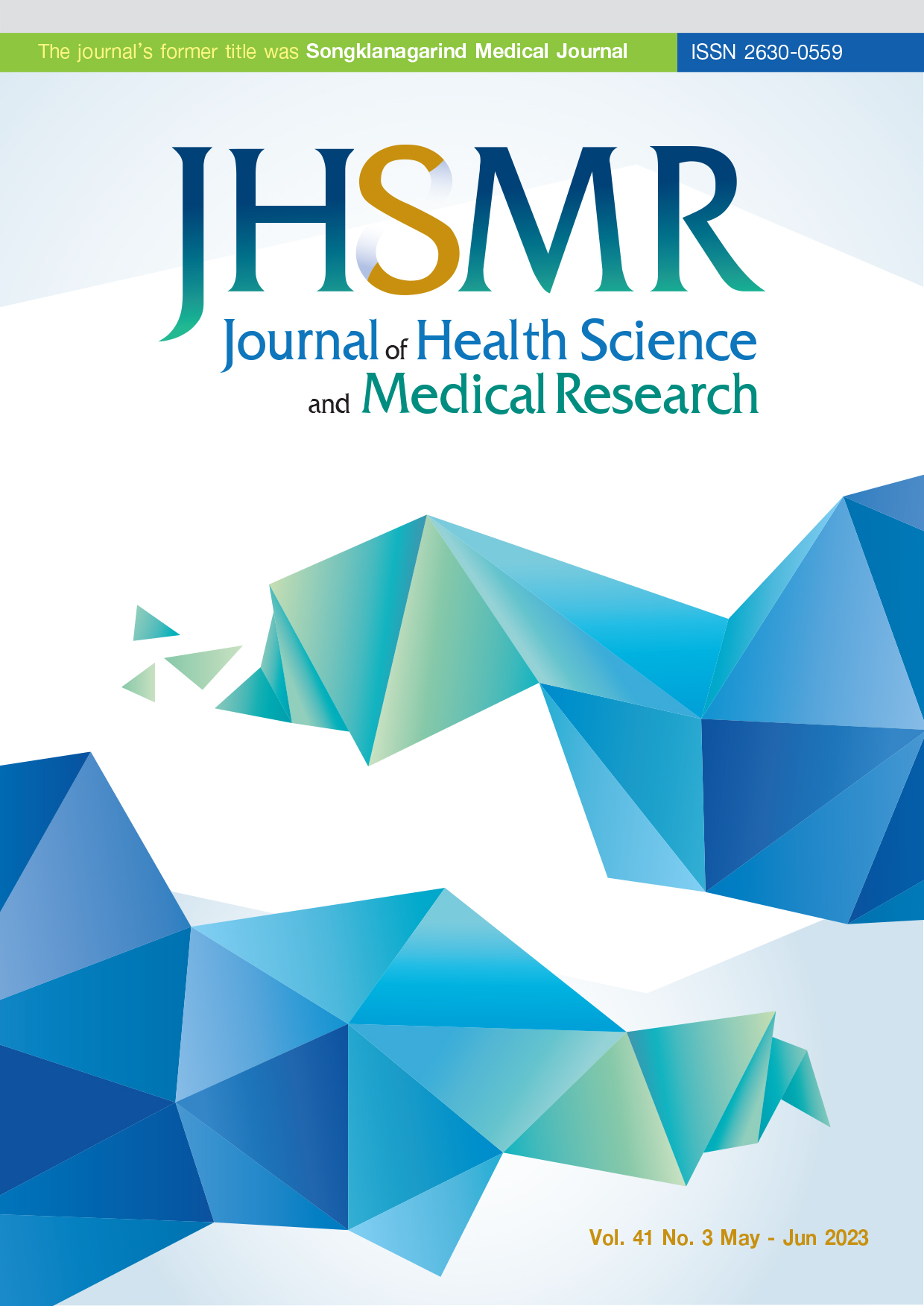Disparities in Stress Coping Strategies among High School Students, in Bangkok, with Various Sexual Orientations and Gender Identities
DOI:
https://doi.org/10.31584/jhsmr.2023938Keywords:
coping, LGBTQ, sexual and gender diversity, sexual and gender minorityAbstract
Objective: To ascertain any relationship between coping strategies, sexual orientation and gender diversity in regard to high school students in Bangkok, and to examine coping strategies among sexual and gender minority youths.
Material and Methods: This cross-sectional survey included 600 students across Bangkok, Thailand. Participants completed an online questionnaire, consisting of demographic data and the Adolescent Coping Scale (Thai version). Descriptive statistics, the Mann-Whitney U test, and the Kruskal-Wallis test were used for data analysis (p-value≤0.05).
Results: The participants included 301 males (50.2%), and 299 females (49.8%), with a mean age of 16.6. The sample identified as 83.7% cisgender, 16.3% non-cisgender (transgender, non-conforming, questioning/unspecified, and others), 64.8% heterosexual, and 35.2% non-heterosexual (homosexual, bisexual, asexual, pansexual, questioning/unspecified, and others). Females used more non-productive coping strategies than males (p-value=0.001), non-cisgender youths used more non-productive coping than cisgender youths (p-value<0.001), and non-heterosexual youths used more non-productive coping than heterosexual youth (p-value<0.001). Coping strategies mostly used by sexual and gender minority male youths were worrying, ignoring the problem, and wishful thinking, while coping strategies most used by sexual and gender minority female youths were worrying, not coping, and keeping to one’s self.
Conclusion: Differences in regards to the sex assigned at birth, gender identity, and sexual orientation had a statistically significant correlation with different coping strategies, specifically in sexual and gender minority youths who used non-productive coping strategies.
References
American Psychological Association. APA dictionary of psychology. 2nd ed. Washington, DC: American Psychological Association; 2015.
Kittiteerasack P, Matthews AK. Definitional issues in the study of sexual/gender diversity among sexual/gender minoity populations in Thailand. J Psychiatr Nurs Ment Health 2017;31:1-15.
American Psychological Association. Guidelines for psychological practice with lesbian, gay, and bisexual clients. Am Psychol 2012;67:10-42.
American Psychological Association. Guidelines for psychological practice with transgender and gender nonconforming people. Am Psychol 2015;70:832-64.
Baqutayan SMS. Stress and coping mechanisms: a historical overview. Mediterr J Soc Sci 2015;6:479-88.
Garcia C. Conceptualization and measurement of coping during adolescence: a review of the literature. J Nurs Scholarsh 2010;42:166-85.
Horwitz AG, Hill RM, King CA. Specific coping behaviors in relation to adolescent depression and suicidal ideation. J Adolesc 2011;34:1077-85.
Suzuki M, Furihata R, Konno C, Kaneita Y, Ohida T, Uchiyama M. Stressful events and coping strategies associated with symptoms of depression: a Japanese general population survey. J Affect Disord 2018;238:482-8.
Freire C, Ferradas MD, Valle A, Nunez JC, Vallejo G. Profiles of psychological well-being and coping strategies among university students. Front Psychol 2016;7:1554.
Brady SS, Tschann JM, Pasch LA, Flores E, Ozer EJ. Cognitive coping moderates the association between violent victimization by peers and substance use among adolescents. J Pediatr Psychol 2009;34:304-10.
Nolen-Hoeksema S. Emotion regulation and psychopathology: the role of gender. Annu Rev Clin Psychol 2012;8:161-87.
Tamres LK, Janicki D, Helgeson V. Sex differences in coping behavior: a meta-analytis review and an examination of relative coping. Pers Soc Psychol Rev 2002;6:2-30.
Hampel P, Petermann F. Age and Gender Effects on Coping in Children and Adolescents. J Youth and Adolesc 2005;34:73-83.
Eschenbeck H, Kohlmann C-W, Lohaus A. Gender differences in coping strategies in children and adolescents. J Individ Differ 2007;28:18-26.
Bullying targeting secondary school students who are or are perceived to be transgender or same-sex attracted: Types, prevalence, impact, motivation and preventive measures in 5 provinces of Thailand. Bangkok: Mahidol University, Plan International Thailand; UNESCO Bangkok. 2014.
Sopitarchasak S, Kihara M, Min Soe K, Ono-Kihara M. Disparities in mental well-being between non-minority and sexual minority male youth in Bangkok, Thailand: quantitative findings from a mixed method study. J Popul Soc Stud 2017;25:83-98.
Jones A, Robinson E, Oginni O, Rahman Q, Rimes KA. Anxiety disorders, gender nonconformity, bullying and self-esteem in sexual minority adolescents: prospective birth cohort study. J Child Psychol Psychiatry 2017;58:1201-9.
Guadamuz TE, Cheung DH, Boonmongkon P, Ojanen TT, Damri T, Samoh N, et al. Illicit drug use and social victimization among thai sexual and gender minority adolescents. Subst Use Misuse 2019;54:2198-206.
Ploderl M, Tremblay P. Mental health of sexual minorities. A systematic review. Int Rev Psychiatry 2015;27:367-85.
Meyer IH. Prejudice, social stress, and mental health in lesbian, gay, and bisexual populations: conceptual issues and research evidence. Psychol Bull 2003;129:674-97.
Hatzenbuehler ML, McLaughlin KA, Nolen-Hoeksema S. Emotion regulation and internalizing symptoms in a longitudinal study of sexual minority and heterosexual adolescents. J Child Psychol Psychiatry 2008;49:1270-8.
Toomey RB, Ryan C, Diaz RM, Russell ST. Coping with sexual orientation-related minority stress. J Homosex 2018;65:484- 500.
Goldbach JT, Gibbs JJ. Strategies employed by sexual minority adolescents to cope with minority stress. Psychol Sex Orientat Gend Divers 2015;2:297-306.
Kelly MM, Tyrka AR, Price LH, Carpenter LL. Sex differences in the use of coping strategies: predictors of anxiety and depressive symptoms. Depress Anxiety 2008;25:839-46.
Sawasdisutha P, Hongsanguansri S. Coping mechanisms among high school students in Bangkok. J Psychiatr Assoc Thailand 2016;61:41-52.
Mingmaung W. The effect of group reality therapy on coping strategies of low academic achievement mathayom suksa three students [master education (counseling psychology)]. Bangkok: Chulalongkorn University; 1997.
Sax L. How common is intersex? a response to Anne Fausto Sterling. J Sex Res 2002;39:174-8.
Pendragon DK. Coping behaviors among sexual minority female youth. J Lesbian Stud 2010;14:5-15.
Sandfort TG, Bakker F, Schellevis F, Vanwesenbeeck I. Coping styles as mediator of sexual orientation-related health differences. Arch Sex Behav 2009;38:253-63.
Riley TJ, Kirsch AC, Shapiro JB, Conley CS. Examining stress and coping as a mediator for internalizing symptomatology: A comparison between sexual minority and majority first-year college students. J Adolesc 2016;49:124-33.
Manalastas EJ, Ojanen TT, Torre BA, Ratanashevorn R, Hong BCC, Kumaresan V, et al. Homonegativity in Southeast Asia: attitudes toward lesbians and gay men in Indonesia, Malaysia, the Philippines, Singapore, Thailand, and Vietnam. Asia-Pacific Soc Sci Rev 2017;17:25-33.
Downloads
Published
How to Cite
Issue
Section
License

This work is licensed under a Creative Commons Attribution-NonCommercial-NoDerivatives 4.0 International License.
























